
Humphrey DeForest Bogart, nicknamed Bogie, was an American actor. His performances in classic Hollywood cinema made him an American cultural icon. In 1999, the American Film Institute selected Bogart as the greatest male star of classic American cinema.

Casablanca is a 1942 American romantic drama film directed by Michael Curtiz and starring Humphrey Bogart, Ingrid Bergman, and Paul Henreid. Filmed and set during World War II, it focuses on an American expatriate (Bogart) who must choose between his love for a woman (Bergman) and helping her husband (Henreid), a Czechoslovak resistance leader, escape from the Vichy-controlled city of Casablanca to continue his fight against the Germans. The screenplay is based on Everybody Comes to Rick's, an unproduced stage play by Murray Burnett and Joan Alison. The supporting cast features Claude Rains, Conrad Veidt, Sydney Greenstreet, Peter Lorre, and Dooley Wilson.
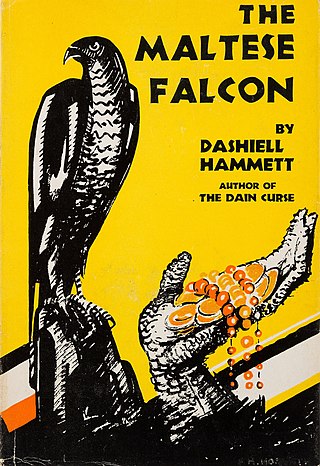
The Maltese Falcon is a 1930 detective novel by American writer Dashiell Hammett, originally serialized in the magazine Black Mask beginning with the September 1929 issue. The story is told entirely in external third-person narrative; there is no description whatsoever of any character's thoughts or feelings, only what they say and do, and how they look. The novel has been adapted several times for the cinema.

Sydney Hughes Greenstreet was a British and American actor. While he did not begin his career in films until the age of 61, he had a run of significant motion pictures in a Hollywood career lasting through the 1940s. He is best remembered for the three Warner Bros. films - The Maltese Falcon (1941), Casablanca (1942), and Passage to Marseille (1944) - with both Humphrey Bogart and Peter Lorre. He portrayed Nero Wolfe on radio during 1950 and 1951. He became an American citizen in 1925.

High Sierra is a 1941 American film noir directed by Raoul Walsh, written by William R. Burnett and John Huston from the novel by Burnett, and starring Ida Lupino and Humphrey Bogart. Its plot follows a career criminal who becomes involved in a jewel heist in a resort town in California's Sierra Nevada, along with a young former taxi dancer (Lupino).

In a Lonely Place is a 1950 American film noir directed by Nicholas Ray and starring Humphrey Bogart and Gloria Grahame, produced for Bogart's Santana Productions. The script was written by Andrew P. Solt from Edmund H. North's adaptation of Dorothy B. Hughes' 1947 novel of the same name.

The Big Sleep is a 1946 American film noir directed by Howard Hawks. William Faulkner, Leigh Brackett and Jules Furthman co-wrote the screenplay, which adapts Raymond Chandler's 1939 novel. The film stars Humphrey Bogart as private detective Philip Marlowe and Lauren Bacall as Vivian Rutledge in a story that begins with blackmail and leads to multiple murders.
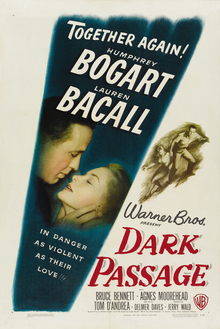
Dark Passage is a 1947 American film noir directed by Delmer Daves and starring Humphrey Bogart and Lauren Bacall. The film is based on the 1946 novel of the same title by David Goodis. It was the third of four films real-life couple Bacall and Bogart made together.
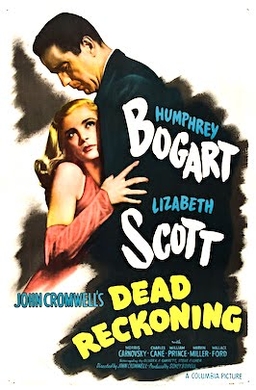
Dead Reckoning is a 1947 American film noir directed by John Cromwell and starring Humphrey Bogart, Lizabeth Scott, Morris Carnovsky, and William Prince. It was written by Steve Fisher and Oliver H.P. Garrett, based on a story by Gerald Drayson Adams and Sidney Biddell, adapted by Allen Rivkin. Its plot follows a war hero, Warren Murdock (Bogart) who begins investigating the death of his friend and fellow soldier, Johnny Drake (Prince). The investigation leads Murdock to his friend's mistress, a mysterious woman whose husband Drake was accused of murdering.
To Have and Have Not is a 1944 American romantic war adventure film directed by Howard Hawks, loosely based on Ernest Hemingway's 1937 novel of the same name. It stars Humphrey Bogart, Walter Brennan and Lauren Bacall; it also features Dolores Moran, Hoagy Carmichael, Sheldon Leonard, Dan Seymour, and Marcel Dalio. The plot, centered on the romance between a freelancing fisherman in Martinique and a beautiful American drifter, is complicated by the growing French resistance in Vichy France.
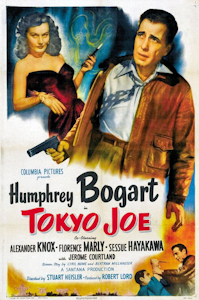
Tokyo Joe is a 1949 American film noir crime film directed by Stuart Heisler and starring Humphrey Bogart. This was Heisler's first of two features starring Bogart, the other was Chain Lightning that also completed in 1949 but was held up in release until 1950.

They Drive by Night is a 1940 American film noir directed by Raoul Walsh and starring George Raft, Ann Sheridan, Ida Lupino, and Humphrey Bogart, and featuring Gale Page, Alan Hale, Roscoe Karns, John Litel and George Tobias. The picture involves a pair of embattled truck drivers and was released in the UK under the title The Road to Frisco. The film was based on A. I. Bezzerides' 1938 novel Long Haul, which was later reprinted under the title They Drive by Night to capitalize on the success of the film.
Aljean Meltsir Harmetz is an American journalist and film historian. She was the Hollywood correspondent for The New York Times from 1978 to 1990.
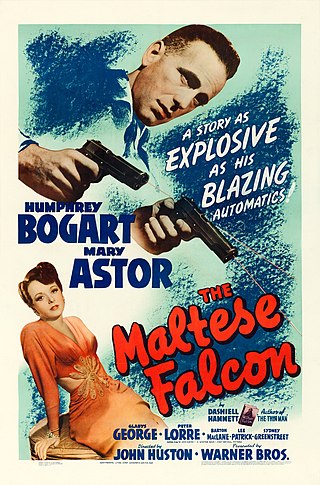
The Maltese Falcon is a 1941 American film noir written and directed by John Huston in his directorial debut. Based on the 1930 novel The Maltese Falcon by Dashiell Hammett, this remakes the 1931 film of the same name.
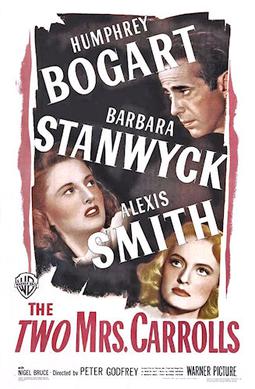
The Two Mrs. Carrolls is a 1947 American mystery film noir directed by Peter Godfrey and starring Humphrey Bogart, Barbara Stanwyck, and Alexis Smith. It was produced by Mark Hellinger from a screenplay by Thomas Job, based on the 1935 play of the same name by Martin Vale.
Manpower is a 1941 American crime melodrama directed by Raoul Walsh and starring Edward G. Robinson, Marlene Dietrich, and George Raft. The picture was written by Richard Macaulay and Jerry Wald, and the supporting cast features Alan Hale, Frank McHugh, Eve Arden, Barton MacLane, Ward Bond and Walter Catlett.
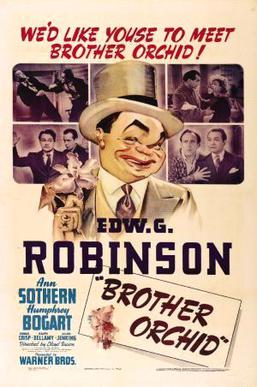
Brother Orchid is a 1940 American crime/comedy film directed by Lloyd Bacon and starring Edward G. Robinson, Ann Sothern and Humphrey Bogart, with featured performances by Donald Crisp, Ralph Bellamy and Allen Jenkins. The screenplay was written by Earl Baldwin, with uncredited contributions from Jerry Wald and Richard Macauley, based on a story by Richard Connell originally published in Collier's Magazine on May 21, 1938. Prior to the creation of the movie version of Connell's story, a stage adaptation was written by playwright/novelist Leo Brady. The script was originally produced at Catholic University of America in Washington, D.C..

Three Strangers is a 1946 American film noir crime drama directed by Jean Negulesco and starring Sydney Greenstreet, Geraldine Fitzgerald, and Peter Lorre, and featuring Joan Lorring and Alan Napier. The screenplay was written by John Huston and Howard Koch. It was produced and distributed by Warner Brothers.
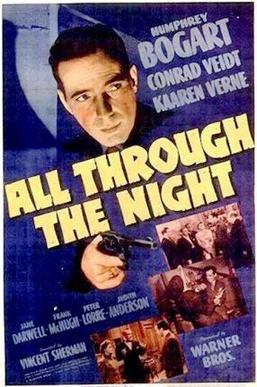
All Through the Night is a 1942 American comedy-crime-spy thriller film directed by Vincent Sherman and starring Humphrey Bogart, Conrad Veidt and Kaaren Verne, and featuring many of the Warner Bros. company of character actors. It was released by Warner Brothers. The supporting cast features Peter Lorre, Frank McHugh, Jackie Gleason, Phil Silvers, Barton MacLane, and William Demarest.

The Big Shot (1942) is an American film noir crime drama film starring Humphrey Bogart as a crime boss and Irene Manning as the woman he falls in love with. Having finally reached stardom with such projects as The Maltese Falcon (1941), this would be the last film in which former supporting player Bogart would portray a gangster for Warner Bros..















